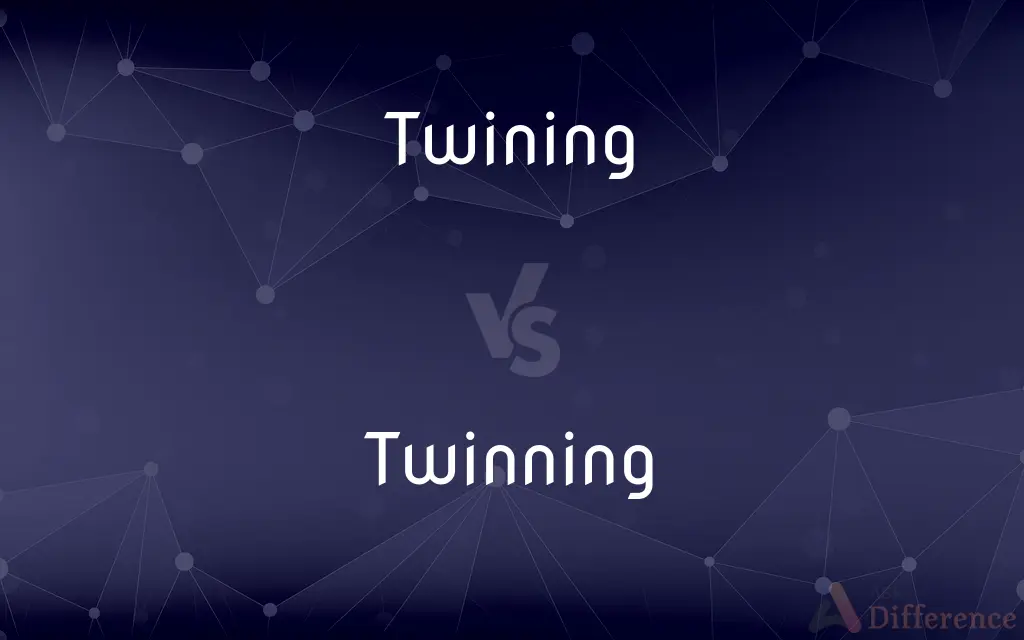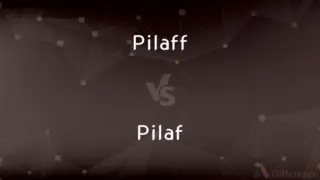Twining vs. Twinning — What's the Difference?
By Tayyaba Rehman — Updated on December 24, 2023
Twining refers to the act of twisting or intertwining things together. Twinning means to pair or link two similar or identical things, or to form a twin relationship.

Difference Between Twining and Twinning
Table of Contents
ADVERTISEMENT
Key Differences
Twining involves the action of winding or twisting two or more items together, often used in the context of plants or fibers. Twinning, on the other hand, describes the process of forming a pair, often referring to identical or similar objects or beings, like twins.
In botany, twining is a growth pattern where a plant winds around a support structure. In contrast, twinning in geology refers to a phenomenon where two crystals grow symmetrically and share some crystal lattice points.
Twining often implies a physical intertwining for stability or design, like vines twining around a trellis. Twinning can signify similarity or duplication, such as in 'twinning' cities, which means forming a partnership between two towns.
In everyday language, twining is less common and usually refers to the specific action of entwining. Twinning has broader applications, from describing identical twins to metaphorically indicating close similarity or mirroring in behavior or appearance.
The terms twining and twinning have distinct meanings but share a common theme of connection, whether it's the physical intertwining of objects or the conceptual pairing of entities.
ADVERTISEMENT
Comparison Chart
Meaning
Twisting or intertwining things together
Pairing or linking similar or identical items
Usage Context
Botany, craft, design
Biology, geology, social relationships
Physical vs. Conceptual
Physical intertwining
Can be physical (twins) or conceptual (sister cities)
Commonality
Less common in everyday language
More commonly used in various contexts
Connotation
Stability, design
Similarity, duplication
Compare with Definitions
Twining
Plants winding around a support.
The beans are twining up the poles in the garden.
Twinning
Forming a pair of identical or similar items.
The twins enjoyed twinning their outfits.
Twining
Creating designs by intertwining materials.
She enjoyed twining wreaths for the holidays.
Twinning
Linking two cities as partners.
The twinning of the two towns promoted cultural exchange.
Twining
Coiling or wrapping for stability.
Twining the rope around the pole secured the tent.
Twinning
In crystallography, the growth of twin crystals.
The geologist studied the twinning patterns in the minerals.
Twining
Interlacing fibers to form a structure.
The artisan was skilled in twining baskets from willow.
Twinning
Mirroring behavior or characteristics.
Their mannerisms were so similar, it was like twinning.
Twining
Entwining or twisting together.
The vines were twining around the fence.
Twinning
Exhibiting close resemblance or duplication.
The two buildings were twinning in architectural style.
Twining
To twist together (threads, for example); intertwine.
Twinning
The bearing of twins.
Twining
To form by twisting, intertwining, or interlacing
Twined the cord from plant fibers.
Twinning
A pairing or union of two similar or identical objects.
Twining
To encircle or coil about
A vine twining a tree.
Twinning
(Mineralogy) The formation of twin crystals.
Twining
To wind, coil, or wrap around something
"She was twining a wisp of hair very slowly around her fingers" (Anne Tyler).
Twinning
Present participle of twin
Twining
To become twisted, interlaced, or interwoven
The branches of one tree twined with those of another.
Twinning
Action of the verb to twin
Twining
To go in a winding course; twist about
A stream twining through the forest.
Twinning
Giving birth to twins
Twining
To wind or coil about something
Morning glories twining about stakes.
Twinning
The pairing of similar objects (such as towns)
Twining
A strong string or cord made of two or more threads twisted together.
Twinning
(crystallography) the formation of twin crystals
Twining
Something formed by twining
A twine of leaves.
Twinning
(transport) the conversion of a road into a dual carriageway
Twining
(countable) A layout or motion that twines.
Twinning
Biparous
Twining
Complaining or grumbling
Twinning
The assemblage of two or more crystals, or parts of crystals, in reversed position with reference to each other in accordance with some definite law; also, rarely, in artificial twinning (accomplished for example by pressure), the process by which this reversal is brought about.
Twining
That twines.
Twinning
Producing two offspring at a time
Twining
Present participle of twine
Twining
Winding around something; twisting; embracing; climbing by winding about a support; as, the hop is a twining plant.
Twining
The act of one who, or that which, twines; (Bot.) the act of climbing spirally.
Common Curiosities
Can twining be used in crafts?
Yes, it's often used in basket weaving and other crafts.
Does twinning always mean identical?
Not always, it can also refer to very similar or closely linked items.
Can twining refer to plants only?
While common in botany, twining can also refer to any act of intertwining.
Is twinning used in biology?
Yes, especially to describe identical twins.
Are twining and twinning synonyms?
No, they have different meanings related to intertwining and pairing, respectively.
Is twining a natural process for some plants?
Yes, many plants naturally twine for support.
Is twining always intentional?
In nature, it's instinctive; in crafts, it's intentional.
Can cities or towns practice twinning?
Yes, twinning is a common term in international relationships between cities.
Can twinning be a cultural practice?
Yes, especially in sister city programs.
Is twining a common term in everyday language?
It's less common and typically used in specific contexts like gardening or crafts.
Does twinning refer to exact duplicates?
In biology, yes; in other contexts, it means very similar.
Can twining be used in art?
Yes, particularly in textile and fiber arts.
Is twinning a modern term?
It's a longstanding term but remains relevant in various fields.
Does twining imply a permanent bond?
Not necessarily; it can be temporary or adjustable.
Can twinning occur in non-living things?
Yes, like in crystals or architecture.
Share Your Discovery

Previous Comparison
Broomstick vs. Broom
Next Comparison
Pilaff vs. PilafAuthor Spotlight
Written by
Tayyaba RehmanTayyaba Rehman is a distinguished writer, currently serving as a primary contributor to askdifference.com. As a researcher in semantics and etymology, Tayyaba's passion for the complexity of languages and their distinctions has found a perfect home on the platform. Tayyaba delves into the intricacies of language, distinguishing between commonly confused words and phrases, thereby providing clarity for readers worldwide.
















































